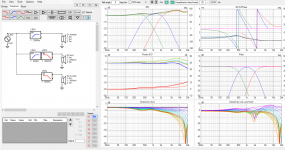Ugh. I goofed my measurements by running sub on accident during the sweeps. Still, some very different results. All measurements were done on-axis and less than 1m.
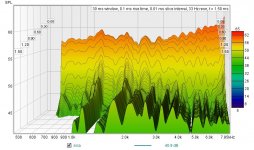
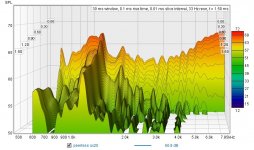
Both tweeters have no eq. One does not do much at the resonance but distorts everything you play, the other has a crazy resonance but less distortion. I was expecting a clear path but have many choices.
I will re-do all of the measurements with the new tweeters.
I did eq the sica lp28 w/o a sub playing:
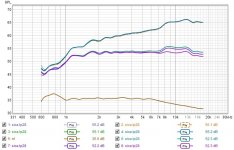
Brown is with nothing playing and is the noise floor. This eq is a bit extreme but I think the sica could be crossed pretty low.
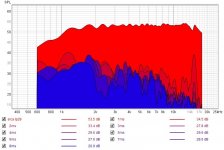
with eq, the decay looks great. I need to play it louder to see the limits since it is very close to the noise floor.
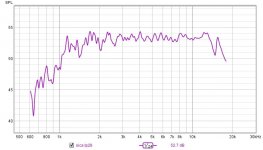


Both tweeters have no eq. One does not do much at the resonance but distorts everything you play, the other has a crazy resonance but less distortion. I was expecting a clear path but have many choices.
I will re-do all of the measurements with the new tweeters.
I did eq the sica lp28 w/o a sub playing:

Brown is with nothing playing and is the noise floor. This eq is a bit extreme but I think the sica could be crossed pretty low.

with eq, the decay looks great. I need to play it louder to see the limits since it is very close to the noise floor.

Been measuring and listening to tweeters. Each tweeter requires its own eq. All measurements are under 1m.
When I was making filters for the peerless ox20 I had the idea of sticking a high Q filter on the FS. There is a shelf filter in the mix too but bringing down the resonance really helped.
It went from this:
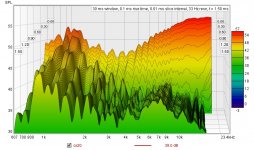
to this:
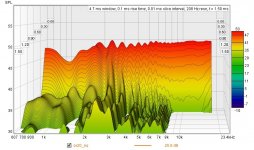
This trick seems most suited for tweeters with a really high impedance. It had less effect on the other tweeters.
As for the other tweeters:
Audax silk:
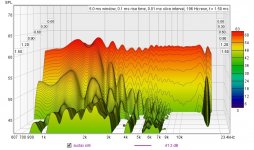
Audax Ti:
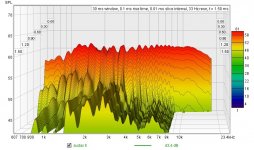
I think the audax is interesting because it is prob. the same motor but a diff. dome.
peerless ox25:
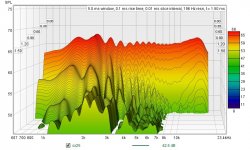
When I was making filters for the peerless ox20 I had the idea of sticking a high Q filter on the FS. There is a shelf filter in the mix too but bringing down the resonance really helped.
It went from this:

to this:

This trick seems most suited for tweeters with a really high impedance. It had less effect on the other tweeters.
As for the other tweeters:
Audax silk:

Audax Ti:

I think the audax is interesting because it is prob. the same motor but a diff. dome.
peerless ox25:

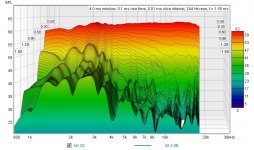
Audax ti... round 3.... under 1m. Short gate.
I made some adjustments to the mic stand and now the bumps are gone. A bit of felt and having the stand level helped.
The tweeter was also moved away from the baffle. This also cleaned up the decay a bit.
The audax ti is my current fav. I only have one metal dome out of the group but I think I am a metal dome guy. More listening will tell me.
I will have to re-measure them all again, again.
started from scratch and made sure all cal files were loaded. I think I mucked up the last measurements. The EQ is much less aggressive now. 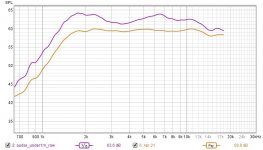
audax ti before and after eq under 1m.
audax TM025C3 1m:
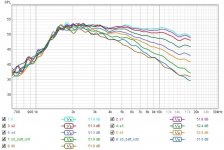
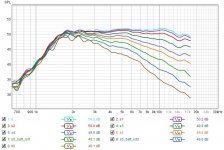
I moved a mic stand around for some of the measurements. A laser distance meter was used to keep the distance the same. The baffle had to be rotated to make the last couple of measurements to get 90 deg.
.

audax ti before and after eq under 1m.
audax TM025C3 1m:


I moved a mic stand around for some of the measurements. A laser distance meter was used to keep the distance the same. The baffle had to be rotated to make the last couple of measurements to get 90 deg.
.
Last edited:
I remember hifijim telling me "there are people who swear that the depth matters in a speaker". This has always stuck in my head since he told me that.
In post 124, the 5ms gate measurement shows a breakup around 890hz (full WL = 15") which is the length of the baffle behind the tweeter.
I tested out a few baffle lengths at 1m and about 45 degrees off-axis. This is just a 1"X1" wide chunk of foam that is either 3", 15", or 30" long behind the 1.57" wide bare tweeter. I used the laser to verify the distance from the mic.
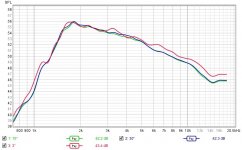
It is so subtle, but notice the change with the 30" baffle before 900hz. With the 3" baffle (4461hz full WL), everything before 4461hz is sloppy. I assume every off-axis measurement would look a little different before 4461hz.
Things are happening roughly at the expected spots. I will need to do this again to verify. I did have to move the mic for the 3" baffle but it was at 1m like the other measurements.
In post 124, the 5ms gate measurement shows a breakup around 890hz (full WL = 15") which is the length of the baffle behind the tweeter.
I tested out a few baffle lengths at 1m and about 45 degrees off-axis. This is just a 1"X1" wide chunk of foam that is either 3", 15", or 30" long behind the 1.57" wide bare tweeter. I used the laser to verify the distance from the mic.

It is so subtle, but notice the change with the 30" baffle before 900hz. With the 3" baffle (4461hz full WL), everything before 4461hz is sloppy. I assume every off-axis measurement would look a little different before 4461hz.
Things are happening roughly at the expected spots. I will need to do this again to verify. I did have to move the mic for the 3" baffle but it was at 1m like the other measurements.
Forgot to add some images...

The graph in the last post had a 500ms gate, the one in this post shows a 5ms gate of the same data. I think the 900hz shift with the 30" baffle can be seen better with a short gate. My guess is I am seeing the diffraction in these measurements. The 2d sims did show this.
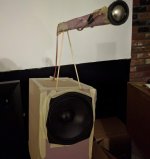
The pic is of the 15" baffle. It is a tiny block of foam with a tweeter taped to it. Two wood skewers are holding it up. I might just use a dowel for the final version. This setup is what I used for the polar and the z baffle test. Is it starting to look like a Dr.Who dalek?
..
The tweeter hunt is just about over. The Eminence sd28 should be out this week. There is also one more sub 43mm metal dome by Tang Band on the way. Maybe sometime next week I will know THE one and start designing a baffle for it.

The graph in the last post had a 500ms gate, the one in this post shows a 5ms gate of the same data. I think the 900hz shift with the 30" baffle can be seen better with a short gate. My guess is I am seeing the diffraction in these measurements. The 2d sims did show this.

The pic is of the 15" baffle. It is a tiny block of foam with a tweeter taped to it. Two wood skewers are holding it up. I might just use a dowel for the final version. This setup is what I used for the polar and the z baffle test. Is it starting to look like a Dr.Who dalek?
..
The tweeter hunt is just about over. The Eminence sd28 should be out this week. There is also one more sub 43mm metal dome by Tang Band on the way. Maybe sometime next week I will know THE one and start designing a baffle for it.
Last edited:
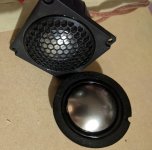
weight w/o wires:
TB S 20-225s: 35.97g
Audax TM025C3: 45.79g
The audax has a shorter depth, is heavier, and has a bigger dome at about the same OD as the 20-224s.
Got the TB Speaker 20-224s in and have it next to the audax. The audax has a plastic covering over the tweeter. I prefer the grill on the TB Speaker tweeter and the sb14st. The 20-224s did require soldering since there is only a pair of pads on the bottom of the tweeter.

Here is the impedance with some of the other tweeters.
Without any eq, I had the tweeter hooked to the DAT3 and used it as the default audio device to play music through it. The TB Speaker 20-224s plays -4db quieter than the audax ti. For an hour I swapped back and forth between the two tweeters keeping the levels matched. The audax still wins for me. Next up will be to measure with REW and see what it sees.
Last edited:
I applied some eq to the TB 20-224s. Compared to the Ti audax, the 20-224s is showing way more baffle boost. I assume this is because the audax has more dome shape than a flat baffle shape to it.
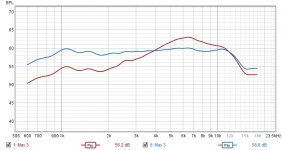
The levels were raised between a few measurements. It took a couple of shelf filters and a few boosts to get flat-ish. This is good enough for now.
What I wondered about after measuring the impedance was the squiggle at 2.5khz. It needed a -1.5db Q:10 filter to clean up. This is a really **** spot to have a shift in time.
Because of the differences in filters required to flatten each tweeter I prob. should not compare w/o eq. So I consider my A/B in the previous post a bit flawed.
Vs the audax ti with eq:
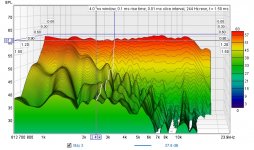
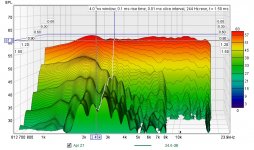
The distance and levels were not exactly matched. Both are under 1m and on-axis.
I do want to compare all the top tweeters at the same SPL to look at the distortion but that will come later.

The levels were raised between a few measurements. It took a couple of shelf filters and a few boosts to get flat-ish. This is good enough for now.
What I wondered about after measuring the impedance was the squiggle at 2.5khz. It needed a -1.5db Q:10 filter to clean up. This is a really **** spot to have a shift in time.
Because of the differences in filters required to flatten each tweeter I prob. should not compare w/o eq. So I consider my A/B in the previous post a bit flawed.
Vs the audax ti with eq:


The distance and levels were not exactly matched. Both are under 1m and on-axis.
I do want to compare all the top tweeters at the same SPL to look at the distortion but that will come later.
Some fake sims out of VCAD. The sim is of an 8" woofer and a tweeter on a 40mm round baffle.
I was wondering if I can keep my tweeter sticking way out past the baffle as I have it now for measuring. VCAD told me, "nope".
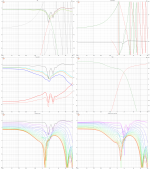
With the tweeter sticking out I get a cancellation.
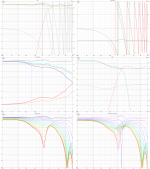
If the tweeter is just 50mm past the woofer it looks much better.
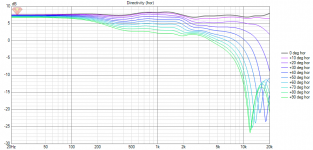
Same as above just out to 90 degrees.
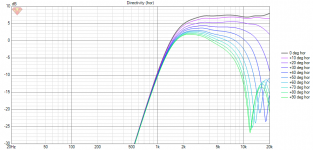
It stinks having to move the tweeter closer to the baffle because this messes with the 3khz decay. Maybe there is a sweet spot? On to measuring for real.....
I was wondering if I can keep my tweeter sticking way out past the baffle as I have it now for measuring. VCAD told me, "nope".

With the tweeter sticking out I get a cancellation.

If the tweeter is just 50mm past the woofer it looks much better.

Same as above just out to 90 degrees.

It stinks having to move the tweeter closer to the baffle because this messes with the 3khz decay. Maybe there is a sweet spot? On to measuring for real.....
I feel like I just went around in a big circle. The baffle hifijim heard 1,000,000 years ago with the sb14 + phl2460 was about the same as my 3rd effort. The first effort was based on guessing and a few measurements. Now I have a sim and the new version is based on that.
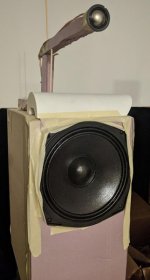
All measurements are under 1m.
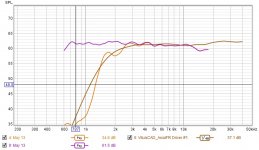
The on-axis of both drivers and just the tweeter vs the sim of the tweeter.
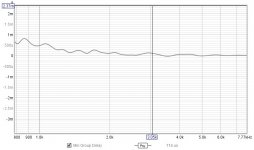
GD
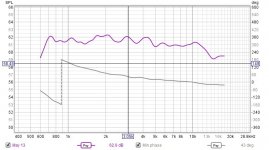
The darn felt fell off that prevents some wobble from my mic but I think having the tweeter near the baffle is adding some. I will dig into that more. The phase looks good. The sweep started at 600hz so I am only looking at 800hz on up.
A rough polar is next.

All measurements are under 1m.

The on-axis of both drivers and just the tweeter vs the sim of the tweeter.

GD

The darn felt fell off that prevents some wobble from my mic but I think having the tweeter near the baffle is adding some. I will dig into that more. The phase looks good. The sweep started at 600hz so I am only looking at 800hz on up.
A rough polar is next.
Last edited:
Made a quick polar with a laser distance meter and moved the mic around a mostly fixed speaker. I had to rotate the speaker for the 90 degree.
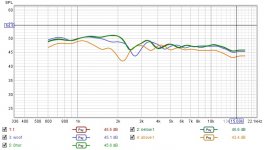
This is 0 degrees to the tweeter at 1m and then I moved the mic stand up and down to see what is happening. The one marked woofer is with the mic at the woofer level.
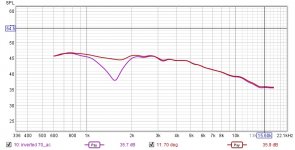
a rough 70 degrees with the tweeter inverted and back.
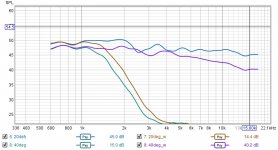
20 and 40 deg with just the woofer and both drivers.
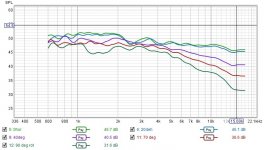
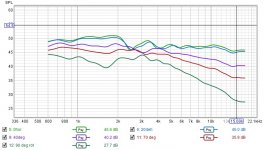
500ms and 4ms gate. Not too shabby?
I have the 44mm rounding near the tweeter. I am wondering if that is causing some issues along with the proximity to the woofer. The XO as-is is nice to hear. I find it impossible to tell if the tweeter or the woofer is playing. There is just one stage.

This is 0 degrees to the tweeter at 1m and then I moved the mic stand up and down to see what is happening. The one marked woofer is with the mic at the woofer level.

a rough 70 degrees with the tweeter inverted and back.

20 and 40 deg with just the woofer and both drivers.


500ms and 4ms gate. Not too shabby?
I have the 44mm rounding near the tweeter. I am wondering if that is causing some issues along with the proximity to the woofer. The XO as-is is nice to hear. I find it impossible to tell if the tweeter or the woofer is playing. There is just one stage.
So I had a mystery after the first polar: What was causing the on-axis drop but made thing perfect off-axis?
I like to ask sims these questions so I moved my tweeter in the "ideal sim":
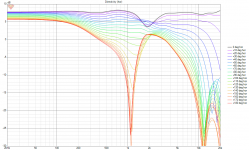
Hey, there is that dip I saw for realz.
So I moved the real tweeter in from its current position:

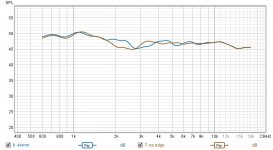
A bit better. The XO and timings all stayed the same for each measurement but the GD shifts:
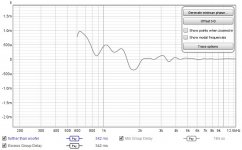
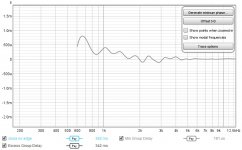
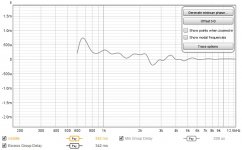

After fixing the Z I did a quick polar:

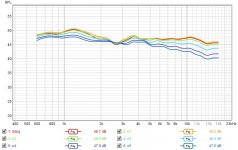
WTF!?! There is still a dip! Ok, I know the Z is the best it can be, what about the Y axis? Well, the sim also says too close can cause a dip here too!
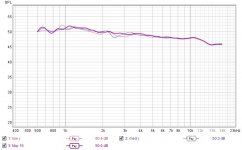
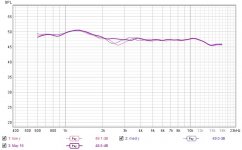
Ok, now I found the Y and Z that works with the XO. This was a bit more complex to measure. I had to raise the mic each time to match the tweeter. All measurements are at 1m.
Here is the on-axis and about 70 degrees off-axis at 1m with a 500ms gate and no 44mm edge on the baffle:

Much closer to the sim. That is enough for tonight but I am excited to measure this more and jam out.
I like to ask sims these questions so I moved my tweeter in the "ideal sim":

Hey, there is that dip I saw for realz.
So I moved the real tweeter in from its current position:


A bit better. The XO and timings all stayed the same for each measurement but the GD shifts:




After fixing the Z I did a quick polar:


WTF!?! There is still a dip! Ok, I know the Z is the best it can be, what about the Y axis? Well, the sim also says too close can cause a dip here too!


Ok, now I found the Y and Z that works with the XO. This was a bit more complex to measure. I had to raise the mic each time to match the tweeter. All measurements are at 1m.
Here is the on-axis and about 70 degrees off-axis at 1m with a 500ms gate and no 44mm edge on the baffle:

Much closer to the sim. That is enough for tonight but I am excited to measure this more and jam out.
Last edited:
Can be a bit of a juggle and I suspect not possible to get "perfect" with such big woofer (in comparison to tweeter). Ever considered adding similarly acoustically small mid driver as the tweeter is in between? Small full range driver in minimal enclosure or even a bit bigger dome?
edit. quickie ideal sim of ~3" mid with no baffle or significant enclosure, much smoother power and DI with third driver there in between.
edit. quickie ideal sim of ~3" mid with no baffle or significant enclosure, much smoother power and DI with third driver there in between.
Attachments
Last edited:
Hi.Can be a bit of a juggle and I suspect not possible to get "perfect" with such big woofer (in comparison to tweeter). Ever considered adding similarly acoustically small mid driver as the tweeter is in between? Small full range driver in minimal enclosure or even a bit bigger dome?
I was happy to solve the riddle with a simple sim. For sure and 8" has flaws. So many hard left or right choices and all will have flaws. I wanted to make these work for a low XO to the sub and have minimal GD shifts to the start of the head shadow range.
on small mids: I have thought about them and have a few to try out. On the other side of the room, an sb14 + dsm50 + phl 2460 is waiting to be compared to this design. It is the other half of the "does this need to be a 4way or 3way" A/B test.
on larger tweeters: Yeah, this is also something that I am wondering about. The sims said 40mm was the limit, but this is for a flat baffle. From my measurements, the dome performs better than the sim. So I do think there is some wiggle room to the size of the tweeter I use as long a big dome is part of the surface. My next step was to pop out the 68mm blieSMa t25b and try it on a stick. I am going to give the audax + phl a listen for a bit before I hack it up.
You slipped this in before i got done with my reply. Those graphs look nice. I will for sure give it a try when I get back to messing with the smaller drivers.edit. quickie ideal sim of ~3" mid with no baffle or significant enclosure, much smoother power and DI with third driver there in between.
https://www.diyaudio.com/community/threads/headshakes-far-field-3way.382393/post-7019280
This is the post that has the XO for the 1" + 8". I had to deal with the flaws of each driver and the XO in place does this and keeps things in phase at the cost of some lag. The real GD looks fine so no biggie. (I assume?)
https://en.wikipedia.org/wiki/Equal-loudness_contour
This is why I think one can ignore problems between 1khz and 2khz as long as they both look the same. The ear expects/ignores a dip.
The xo in place keeps 2-5khz most intact.The human auditory system is sensitive to frequencies from about 20 Hz to a maximum of around 20,000 Hz, although the upper hearing limit decreases with age. Within this range, the human ear is most sensitive between 2 and 5 kHz, largely due to the resonance of the ear canal and the transfer function of the ossicles of the middle ear.
Last edited:
I just thought to suggest possible path forward if you look to improve on the graphs, use smaller mid, or bigger tweet, can't get much better than what you already have with 1" and 8" 😉
Experimenting is best way to solve it, as you have though. Concern for rising group delay is real when adding more ways to a system, not sure if this is something to be afraid of though. Perhaps the third way makes the system nicer nevertheless, but it remains for you to judge. I think even simple quick prototypes can give very good approximation what the sound is. This I know, the group delay (or something else in my 3-way crossover) can make the sound bit more boring and some other settings make it all lively, even though the simulations (including power and DI) look very much the same given accuracy of measurements. While it might be configuration error on my part it might be just the impulse response thats bit different for both, or just some small shift on frequency response balance that makes it. I've been lazy and haven't really tracked down what makes the difference 😀 As long as it sounds good it doesn't matter if there is blimp in some graph. Carry on 🙂
Experimenting is best way to solve it, as you have though. Concern for rising group delay is real when adding more ways to a system, not sure if this is something to be afraid of though. Perhaps the third way makes the system nicer nevertheless, but it remains for you to judge. I think even simple quick prototypes can give very good approximation what the sound is. This I know, the group delay (or something else in my 3-way crossover) can make the sound bit more boring and some other settings make it all lively, even though the simulations (including power and DI) look very much the same given accuracy of measurements. While it might be configuration error on my part it might be just the impulse response thats bit different for both, or just some small shift on frequency response balance that makes it. I've been lazy and haven't really tracked down what makes the difference 😀 As long as it sounds good it doesn't matter if there is blimp in some graph. Carry on 🙂
I just thought to suggest possible path forward if you look to improve on the graphs, use smaller mid, or bigger tweet, can't get much better than what you already have with 1" and 8" 😉
Experimenting is best way to solve it, as you have though. Concern for rising group delay is real when adding more ways to a system, not sure if this is something to be afraid of though. Perhaps the third way makes the system nicer nevertheless, but it remains for you to judge. I think even simple quick prototypes can give very good approximation what the sound is. This I know, the group delay (or something else in my 3-way crossover) can make the sound bit more boring and some other settings make it all lively, even though the simulations (including power and DI) look very much the same given accuracy of measurements. While it might be configuration error on my part it might be just the impulse response thats bit different for both, or just some small shift on frequency response balance that makes it. I've been lazy and haven't really tracked down what makes the difference 😀 As long as it sounds good it doesn't matter if there is blimp in some graph. Carry on 🙂
Cheers.
I hope you dig into your 3way. I know I have my 1st one that could use a XO redesign. Be sure to post about what you do when you do it and hopefully it will motivate me to re-do mine too.
....
Reality vs sims.
When I moved the tweeter I could have just fixed the timing but my interest was in matching reality to a sim. It turns out reality was +75mm higher and -50mm further back than the sim. But the sim was based on a fixed SD. In reality, the driver measured better than the sim. I wondered if I could tighten up the sim a little and make it match reality a bit more. This would let me measure less and get a more accurate XO if it works.
All of these images are the same graph just a diff. view and with an extra plot. It is of a 40mm baffle. The blue line is 0deg and the red line is 90 degrees with the same SD. The dotted lines are showing the SD shift from a high/low number.
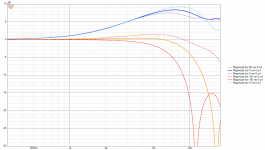
The green line is the no eq on-axis from the audax ti tweeter. The impulse was exported out of REW, converted with vcad's tool with a +5db adjustment, and imported into the baffle sim. So the position is just random but it is neat to see how much lines up.
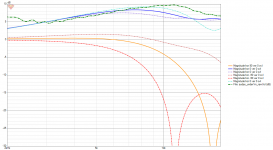
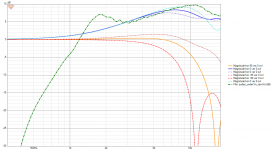
The hump on the green line around 1500hz is the FS. So that aside, it tracks for much of the sim BUT it tracks best for the line where I adjusted the SD to an extreme. So maybe a variable SD in a sim could be a good thing? It might just make the higher freq more accurate if these graphs are right. So this would not really help a 1-2khz XO.
Next up is to repeat this by just doing a 0 and 90 degree on the woofer and tweeter. I am curious how the woofer holds up to a sim.
..
Last edited:
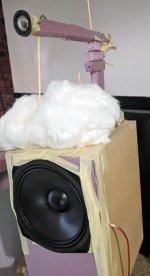
I was asked, "why does your speaker have white hair?" Uh, it is for the holidays! Really I was just testing out how much the top baffle was messing with things.
This is v4 that matches the ideal sim. You can see all the foam chunks added to match the sim. Precision is key! ;P
I made a new ideal XO that should let me bring the tweeter forward. So testing that is something on the to-do's. I also want to test an LR4 at the current spot and see what happens with that.
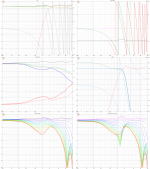
I am still liking the sound. None of the tracks I have found sibilant on other larger baffle configurations are with this setup. IMO Baffle diffractions = sibilance and double echos. What I hear now is detail where before it was just a plain sound that made the baffle stand out. So an "s" sound goes from an "SSSSsss' into an "S with room echo". If that makes sense.
The big shock is the phase. The phase effects in tracks did not show up as strong until the on-axis power was fixed. Now that things are all lined up I am hearing them in spades.
More later...
A tiny update....

The foam behind the tweeter will be replaced with a fancy 18" dowel. The audax domes for this project will get the wenge wood and the purpleheart is for larger tweeter tests. There is one coat of "tried & true" on them.
Next up is to make a wood baffle to transition from the audax tweeter to the dowel.

The foam behind the tweeter will be replaced with a fancy 18" dowel. The audax domes for this project will get the wenge wood and the purpleheart is for larger tweeter tests. There is one coat of "tried & true" on them.
Next up is to make a wood baffle to transition from the audax tweeter to the dowel.

A pair of these have been ordered. I flip-flopped on bass drivers for a few months. My first target was a pair of tens for each side but found that was too tall for my needs after building a mockup.
I hope by next week I am doing flips like that while listening.
A very large pair of parts express denovo boxes are also on the way.
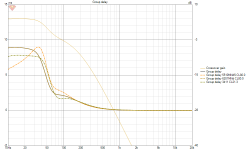
The target GD with the XO and enclosure sim. Hopefully reality will match. It would also be nice to not boost the real thing so much.
This far-field project is looking locked in as a 3way with all of the drivers selected:
tweeter: audax TM025C3
mid: phl 2460
woofer: phl 6201
There is a 3way version with the sb14+dsm50+phl2460 to A/B but that is just a test box.
Next up is some box building and woofer/mid testing.
- Home
- Loudspeakers
- Multi-Way
- Headshake's far field 3way

